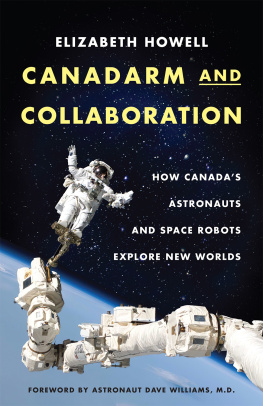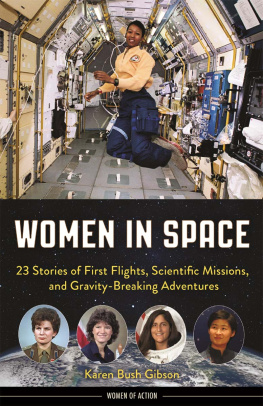Foreword
I remember reading once that a plane cannot tell if its pilot is a man or a woman. I was profoundly struck by it. Of course , I thought to myself, its so obvious . But for most of our history with aviation, women were told their place was not in the cockpit or the flight deck, or anywhere near an airplane except, perhaps, as a stewardess, as flight attendants were called back then.
Elizabeth Muir shows through the stories in this book that though they were discouraged from it, women wanted desperately to work in aviation from its earliest days. Through determination, pluck, and training, women like Katherine Stinson Otero, Elsie MacGill, Vi Milstead Warren, Felicity McKendry, Roberta Bondar, Maryse Carmichael, and others that you will meet in the pages of this book, accomplished amazing things and reached their dreams. They flew the first flying contraptions, which were just a collection of struts and wires, all the way through to bush planes, four-engine military bombers, water bombers, and helicopters. They designed and built warplanes and trainers. They went into the skies and into space.
Like many of these women, I never set out to be a pioneer when I became the first female president of the Canadian Aviation Historical Society in its fifty years of existence. I just followed my interests, put my hand up when the opportunity arose, and then worked as hard as I could to do a good job. I had to earn respect, as anyone would, but my gender never caused any commotion other than pleasant surprise among some that a young woman would be interested in aviation history. Even this reaction, however, twigged me to the fact that for some it never occurred to them that women would be interested in this sort of thing a quiet prejudice all in itself.
Unfortunately there remain those who still vocally resist female flyers, mechanics, astronauts, and other roles traditionally closed to women. Luckily, they are few and far between. When the WestJet passenger wrote his comment about lady pilots on a napkin in 2014, it quickly went viral on the Internet. The fact that it happened right around Women in Aviation Day felt particularly ironic. I was so happy to see that critics ranging from journalists in traditional media to everyday people on social media unilaterally slammed it as archaic, sexist thinking, and I hope that gentleman has changed his mind.
The thinking around womens roles in aviation might be shifting, but there needs to be a critical mass in civil, military, and commercial aviation to boost the tiny numbers that currently exist. We are playing catch-up now from the decades when there were hardly any women in the field. It was not that long ago that they had to battle uphill the whole way, conform to very narrow standards, and sometimes even stay invisible to passengers. It has really only been since the 1970s or 1980s when women like Lorna de Blicquy and Rosella Bjornson were making their mark, and perhaps twenty-five years since little girls might encounter more than a handful of examples to follow.
Seeing one pioneer in a pilots uniform is not enough to push the eager but reluctant dreamers in our lives. Girls need to see female airline CEOs, baggage handlers, ticket agents, and flight crew early and often in the books they read, the shows and movies they watch, and in the media more generally. They need events like Girls Can Fly, Women in Aviation Day, and the Elsie MacGill Foundations Northern Lights Awards to give them opportunities to experience flight and gain mentors. They need encouragement from parents, teachers, and other adults of both genders in their lives.
You have taken that step by reading this book and perhaps lending or giving it to a girl or woman in your life. Who knows what adventure or career path you have sparked, what passion you have inspired? I have had the opportunity to write about and meet many amazing pioneering women, including some of the ones mentioned in this book, and they are truly inspirational. But many of them are also surprisingly normal, which makes the dream of working in avionics, aeronautical engineering, or air traffic control seem possible. It makes a young girl think, hmmm, if she could do it, so can I!
It may sound strange, but I cannot wait for the day when there are no longer new female trailblazers in aviation. I cannot wait for the day when it is a normal, everyday occurrence to see women in aviation, from bush to boardroom to blasting off into space. Hopefully this book and others like it will help make that happen.
Danielle Metcalfe-Chenail
Historian Laureate for the City of Edmonton, Alberta
Author, Polar Winds: A Century of Flying the North
Preface
I do not fly. That is, I do not pilot a plane or a space ship, but I am fascinated by flight. No matter how often the mechanics of flight is explained to me, I consider it one of lifes magical mysteries.
I remember how excited I was as a child when I won a short plane ride as a prize for designing a poster for a local fair. As I was helped up, I could hardly believe I was stepping into a plane. My father was watching enviously, for he had never been in a plane either, but I was loath to give up my place. The ride ended far too quickly.
Later, I dreamed of becoming a stewardess, but I was discouraged when I found out you had to train to be a nurse first.
The impetus for writing this small book, however, is somewhat different. Just recently, British Airways told the story of two young children who were visiting the flight deck on one of their planes. The female pilot, Aoife Duggan, asked the children if they would like to fly a plane too. The young boy said yes, but the six-year-old girl replied that shed like to be an air hostess. Boys are pilots, she explained to the female pilot.
Events among my friends led me to discover that many young girls are still dreaming of careers that were considered proper for women half a century ago and not looking at the exciting possibilities of the non-traditional vocations and professions that were closed to women in the early twentieth century, but now are theoretically wide open to all.
I began to look at statistics and discovered to my amazement that many women are still not participating in certain careers, either because they have not been encouraged, or because they do not think them attractive or suitable. Perhaps the most startling example is in aviation. Women make up only six percent of air pilots, flight engineers, and flying instructors in Canada today.
This is the reason for this book to illustrate the tremendous contribution Canadian women have made to the airline industry over the past one hundred years, and to encourage mothers and grandparents, teachers, and all those who come into contact with young people, to tell the story of women in the air and inspire both girls and boys, women and men, to consider aviation as a career path.
















